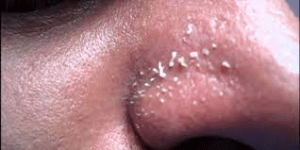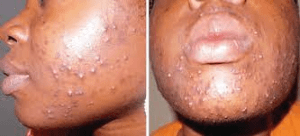Acne is a common skin condition that affects people of all ages. There are different types of acne, each with its own set of causes and treatments. In this article, we will discuss the different types of acne and their respective treatments.
The most common types of acne are:
Blackheads: Blackheads are small, dark-colored bumps that form when hair follicles become clogged with oil and dead skin cells. If the pore fills with debris but stays open, you’ll see a blackhead. The black dots aren’t dirt, so resist scrubbing. It will only worsen your acne. To unclog pores, dermatologists recommend using a retinoid like adapalene, without a prescription. You’ll also want to use a benzoyl peroxide or Salicylic Acid Wash. It can help get rid of the excess P. acnes bacteria on your skin.

Whiteheads: Whiteheads are small, white bumps that form when hair follicles become clogged with oil and dead skin cells. If the pore closes up, you’ll see a tiny bump that looks white or flesh colored.They can be treated with over-the-counter acne treatments that contain benzoyl peroxide or salicylic acid.

Papules: Papules are small, red bumps that can form when the skin is irritated or inflamed. When excess oil, bacteria, and dead skin cells push deeper into the skin and cause inflammation (redness and swelling), you’ll see small, red bumps. The medical word for this type of acne blemish is a papule they feel hard. If you have a lot of papules, the area may feel like sandpaper. To clear this type of acne blemish, try washing your face twice daily with an acne face wash that contains benzoyl peroxide or salicylic acid. If you have a lot of papules, it can be helpful to see a dermatologist.

Pustules: Pustules are small, red bumps that are filled with pus. The medical term for this type of acne blemish is pustule. These blemishes are a lot like papules, except that pustule contain a yellowish fluid. You’ll often see a yellow- or white-colored center, as shown here. To treat, wash your face with an acne product that contains benzoyl peroxide or salicylic acid. Resist the temptation to pop these, It can worsen acne. If you don’t see results from treatment in six to eight weeks, see a dermatologist.

Cysts: Cysts are large, painful bumps that form deep beneath the skin. These acne blemishes penetrate deep into the skin, and often cause permanent acne scars when they heal. If you have acne that looks like this, you’ll need a dermatologist’s help to treat it. The sooner you start treatment, the fewer permanent scars you’ll have. They can be treated with prescription medications, such as antibiotics or isotretinoin.

Acne can be a nuisance, but there are treatments available that can help. If you’re struggling with acne, talk to your doctor or a dermatologist to find the best treatment for you.


